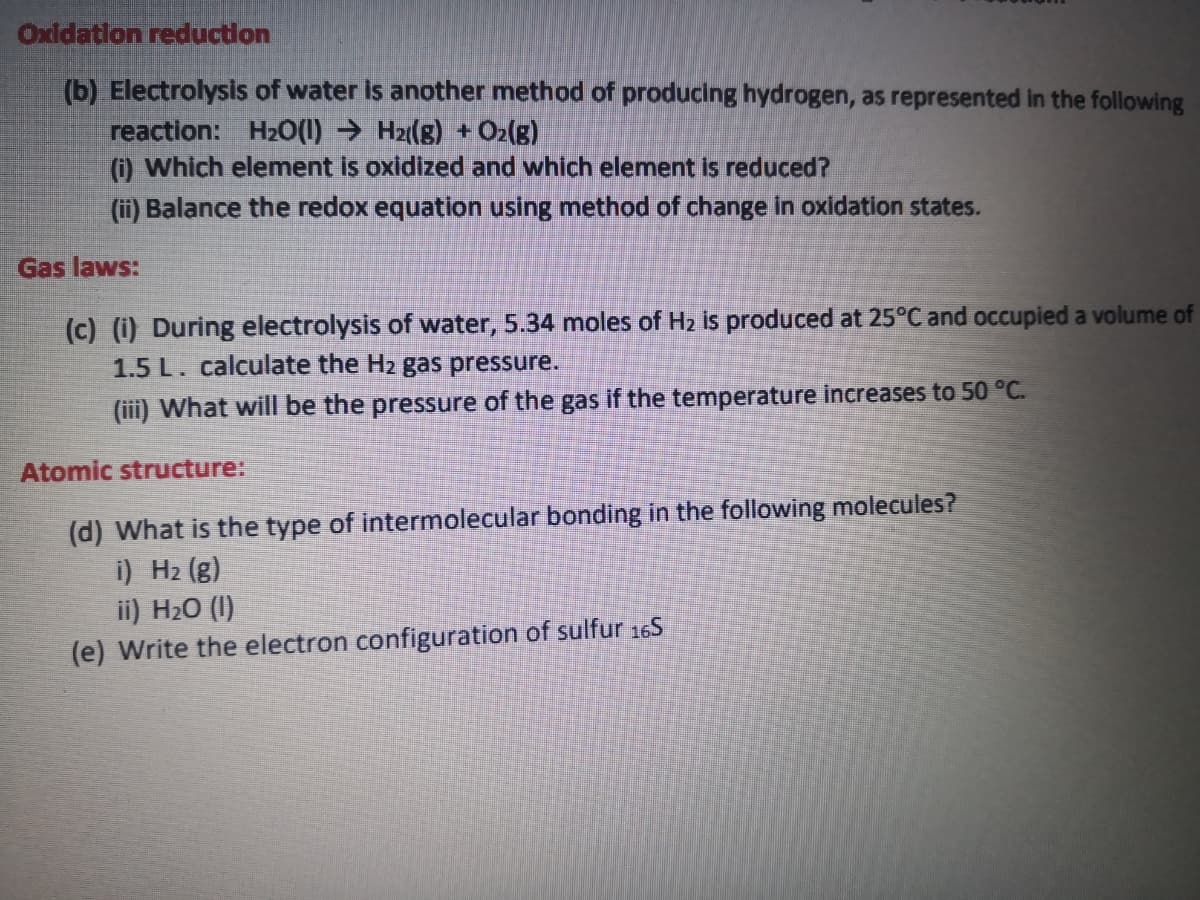Oxldation reduction (b) Electrolysis of water is another method of producing hydrogen, as represented in the following reaction: H2O(1) H2((g) + O2(8) (i) Which element is oxidized and which element is reduced? (ii) Balance the redox equation using method of change in oxidation states. Sas laws: (c) (i) During electrolysis of water, 5.34 moles of H2 is produced at 25°C and occupied a volume of 1.5L. calculate the Hz gas pressure. (iii) What will be the pressure of the gas if the temperature increases to 50 °C.
Oxldation reduction (b) Electrolysis of water is another method of producing hydrogen, as represented in the following reaction: H2O(1) H2((g) + O2(8) (i) Which element is oxidized and which element is reduced? (ii) Balance the redox equation using method of change in oxidation states. Sas laws: (c) (i) During electrolysis of water, 5.34 moles of H2 is produced at 25°C and occupied a volume of 1.5L. calculate the Hz gas pressure. (iii) What will be the pressure of the gas if the temperature increases to 50 °C.
Chemistry: The Molecular Science
5th Edition
ISBN:9781285199047
Author:John W. Moore, Conrad L. Stanitski
Publisher:John W. Moore, Conrad L. Stanitski
Chapter19: The Chemistry Of The Main-group Elements
Section: Chapter Questions
Problem 31QRT
Related questions
Question

Transcribed Image Text:Oxldatlon reduction
(b) Electrolysis of water is another method of producing hydrogen, as represented in the following
reaction: H20(1) → H2((g) + Oz(g)
() Which element is oxidized and which element is reduced?
(ii) Balance the redox equation using method of change In oxidation states.
Gas laws:
(c) (i) During electrolysis of water, 5.34 moles of H2 is produced at 25°C and occupied a volume of
1.5 L. calculate the H2 gas pressure.
(iii) What willI be the pressure of the gas if the temperature increases to 50 °C.
Atomic structure:
(d) What is the type of intermolecular bonding in the following molecules?
i) H2 (g)
ii) H20 (I)
(e) Write the electron configuration of sulfur 165
Expert Solution
This question has been solved!
Explore an expertly crafted, step-by-step solution for a thorough understanding of key concepts.
This is a popular solution!
Trending now
This is a popular solution!
Step by step
Solved in 3 steps

Knowledge Booster
Learn more about
Need a deep-dive on the concept behind this application? Look no further. Learn more about this topic, chemistry and related others by exploring similar questions and additional content below.Recommended textbooks for you

Chemistry: The Molecular Science
Chemistry
ISBN:
9781285199047
Author:
John W. Moore, Conrad L. Stanitski
Publisher:
Cengage Learning

Chemistry & Chemical Reactivity
Chemistry
ISBN:
9781337399074
Author:
John C. Kotz, Paul M. Treichel, John Townsend, David Treichel
Publisher:
Cengage Learning

Chemistry & Chemical Reactivity
Chemistry
ISBN:
9781133949640
Author:
John C. Kotz, Paul M. Treichel, John Townsend, David Treichel
Publisher:
Cengage Learning

Chemistry: The Molecular Science
Chemistry
ISBN:
9781285199047
Author:
John W. Moore, Conrad L. Stanitski
Publisher:
Cengage Learning

Chemistry & Chemical Reactivity
Chemistry
ISBN:
9781337399074
Author:
John C. Kotz, Paul M. Treichel, John Townsend, David Treichel
Publisher:
Cengage Learning

Chemistry & Chemical Reactivity
Chemistry
ISBN:
9781133949640
Author:
John C. Kotz, Paul M. Treichel, John Townsend, David Treichel
Publisher:
Cengage Learning

Introductory Chemistry: A Foundation
Chemistry
ISBN:
9781337399425
Author:
Steven S. Zumdahl, Donald J. DeCoste
Publisher:
Cengage Learning

Chemistry: Principles and Reactions
Chemistry
ISBN:
9781305079373
Author:
William L. Masterton, Cecile N. Hurley
Publisher:
Cengage Learning

General Chemistry - Standalone book (MindTap Cour…
Chemistry
ISBN:
9781305580343
Author:
Steven D. Gammon, Ebbing, Darrell Ebbing, Steven D., Darrell; Gammon, Darrell Ebbing; Steven D. Gammon, Darrell D.; Gammon, Ebbing; Steven D. Gammon; Darrell
Publisher:
Cengage Learning